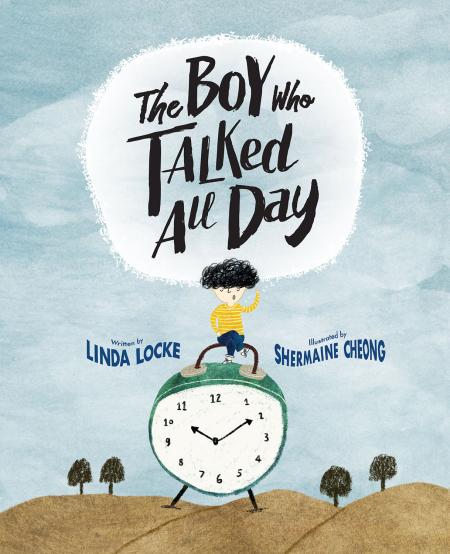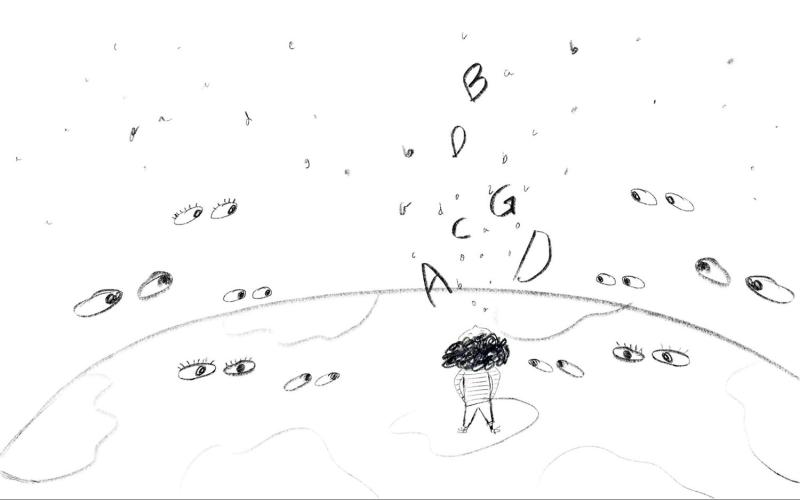The Boy Who Talked All Day
By Linda Locke, illustrated by Shermaine Cheong
A memorable tale, in playful rhyme, of why we should always pay attention to our surroundings. There once was a boy who loved to talk. He talked so much that he couldn’t even notice when danger was coming! The Boy Who Talked All Day recalls the classic nursery rhymes, and its whimsical illustrations are certain to delight and amuse children of all ages.

Linda Locke (Author)
Linda Locke is the co-author of Agnes and Her Amazing Orchid, a picture book about the creator of the Vanda Miss Joaquim. Linda was previously chief executive of Saatchi & Saatchi Advertising, as well as the chairman and regional creative director of Leo Burnett Advertising. She has more than 300 creative awards to her name. She later started her own consultancy, Godmother Pte Ltd, and held several key positions at Club21.

Shermaine Cheong (Illustrator)
Shermaine Cheong (aka See You See Me) is currently on an illustration journey, which began while she was working in advertising and design. Her love for form, textures, and colours led her to explore how she could bring her ideas to life creatively. Using a blend of water-soluble colour pencils, pastels, and digital painting, Shermaine hopes to share stories and messages in her illustrations that can brighten one’s day, or leave you with something unexpected—making you go “awww” at the simple joys of everyday life and common scenarios.
Feature Interview
Linda Locke and Shermaine Cheong, the author-illustrator duo of The Boy Who Talked All Day, share how they worked together to create this unique picture book filled with lovely rhyme and mesmerising illustrations.
What do you hope children will take away from this story?
Linda: I'd like to think that children will actually have two lines of thought that come out of the story. One, they actually should be interested in everything that's going on around them. They should not walk with their faces in their phones or even in a book. When they're outside, they should basically absorb what's outside and notice all the little tiny things that go on around us that make life really interesting and rich and fun.
But on the other hand, not to do it in such a way that they put themselves in any kind of danger, or that by being so overly focused, they end up missing out on some really fun things, you know, or interesting things that they would enjoy. So it's trying to find a balance basically, between having ideas, having thoughts, but at the same time, not losing out on what's going on around them and not putting themselves in harm's way.
Who or what inspired the protagonist of the story? Is there anyone in real life?
It would be my son who is now going to be 26. As it happens, he was always curious and mischievous. And he would just absorb everything around him like a little sponge, but he also had an opinion on everything. And he wasn't afraid to talk and speak out, often at the most inappropriate times, like walking up to strangers and telling them how old their mother was, and things like that. Which was not very nice.
But yeah, my son, he really helped me see the world through a child's eyes again and again, and to see the things they find really interesting that often as adults, we miss out. And it gave me a way of appreciating my environment, and also appreciating him and his perspective on things on what made him feel curious: what interested him and what he thought about it that encouraged him to express himself. But again, a few times he would go off and do things like disappear and hide and give me fright, because I couldn't find him. So the character has been really based around him six, seven year old child.
So it was like a tribute to him of some sort.
In a way, yes. Because he's my only child. I had him when I was in my 40s through IVF, so he was kind of a bit of a miracle, frankly. All children are gifts, but because of what it took for me to go through IVF and everything to have him, he really truly felt like a miracle child. So maybe I paid even more attention to him than a lot of other mothers might do if they had the luck of having a baby very easily. I don't know, but I tried to enjoy every single moment with him that I could.
The book contains elements of rhyme, were there any particular children's rhymes that inspired the book?
I've always liked Dr. Seuss, and Dr. Seuss was a collection that I had and I also bought for my son. I used to also love limericks. And of course, we all grew up with children's rhymes, “Jack and Jill went up the hill” and those sorts of things.
What I like about rhyme is it allows you to tell a story in a very joyful way, and often in a very whimsical and funny way. It allows you to play with the words and the sounds that words make. And I think it's a different way of telling a story that's very engaging. And the cadence of it, I find, has a lovely ability to flow you through a story, almost as if you were riding on a boat sailing on the sea. There is something quite magical about rhymes.
And it's very, very different from just a straightforward story. I had always had a bit of an itch to try it to see if I could do it. And this was my first effort. And in doing so, I've actually written a few more, depending on how this first book goes with the public. And I would love to see us having in Singapore sets of rhyming stories. I would love to think of myself as Dr. Seuss. But I think it's a bit ambitious. But that's really what attracted me to it is the whole musicality of a way of telling a story that allows it to stick in your mind.
From your perspective, this is what would engage children in this magical fantasy land.
I think it's the short sentences; it's a very easy read for children. But there is a pleasure in the readings where it’s not just the words and what the words tell you. There is something viscerally pleasurable about reading a word in the sentence and reading it in a rhyme. Somehow the rhyme is more fun, it's just more engaging. It's cute, you know? And you can see when the children have been reading the book, they're smiling away, because they're enjoying that. It's like a physical experience for them beyond the meaning of the words.
How did you first start out illustrating this picture book, and what were some of your inspirations?
Shermaine: I started out with, of course, reading Linda's manuscripts. And her illustrative notes were very useful for me because she has a very strong vision of how the book should look like. So with her description of each scenario, or rather each spread, and how she would like it to be, gave me the head start of how I could illustrate the book. We also got our main inspiration from one of Oliver Jeffers’ book called A Child of Books. It was a great study to see how we could blend my illustrations with typography visuals.
(The text you see in the illustrations were written by Linda as well.)
Bonus question: Linda, would you like to share about the unique typography that was used in the book?
Linda: It was very much part of the construction of the visual of the book. We decided that if he was going to be talking, then we needed to have the conversation very much part of the visual element. It was something that developed along the way with the input of the publisher.
He said, “You know, I think we can't just put blah, blah, blah, it's not really meaningful in the context of the visual.” So I actually added the sort of conversation to loosely fit the context of each scene.
I had to work really closely with Shermaine, who was absolutely brilliant about it, to make sure that the way that the illustrations and the typography flowed. They became one and the same, and they became part of the whole. And the idea was that, you know, with a lot of children today, watching games and stuff, they are little easter eggs that they find. So you can read this book through the main rhyme, but then you also get another layer, which is to read into what he was talking about. And we get to know the character a little bit better, or a little bit more.
So I think it makes the book have a lot more depth to it than it might otherwise have had. There is also obviously a typographical element to it, which makes the whole picture something really pleasurable to look at. The typography complements the picture and the story and vice versa.
What are some of the techniques you use often in your illustrations?
Shermaine: My work is a blend of water soluble coloured pencils, wax pastels, and combination with digital painting. I use ProCreate on my iPad. These are the three things that I usually combine with my illustrations because I love textures. I'm constantly experimenting with different ways to see how I can create different stuff when I blend the three different media.
How did you overcome any creative blocks or challenges when illustrating the picture book?
I talked with Linda when I was stuck at a certain scenario, when I can't see it. So we will work quite closely together. When I can't see a certain scene being formed in my head, I would call her. So she is my first go-to solution. Now if I'm really stuck, and I cannot get the scenario in my head, I will just go for a long walk, or run, just to distract myself away from the picture book so that yeah, the idea somehow it will just drop.
Is there any difference illustrating a picture book versus other types of illustrations?
I actually don't take any commercial commission work, other than picture books. I'm very selective. If not, I'll be drawing my own stuff. So there's not much difference.
Why do you choose to only take on picture books then?
Because I really love picture books. It's a joy to see the story coming to life with my illustrations. That's why I love illustrating picture books and not working with commercial clients. It is different. The joy is different for me.
Check out The Boy Who Talked All Day at our Festival Bookstore now!



